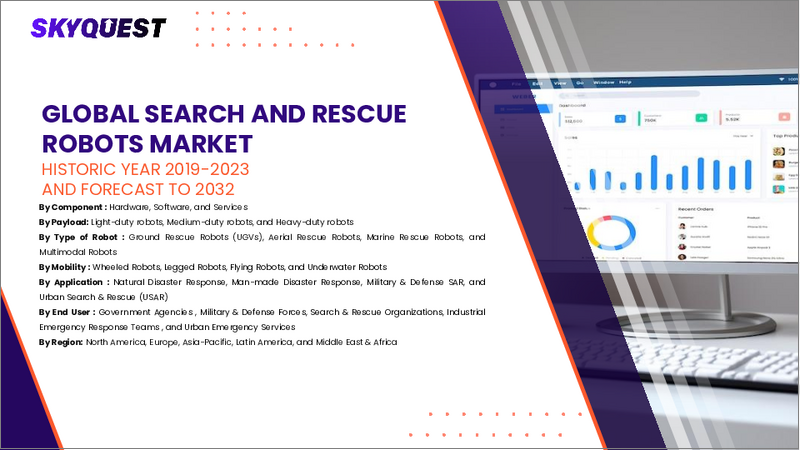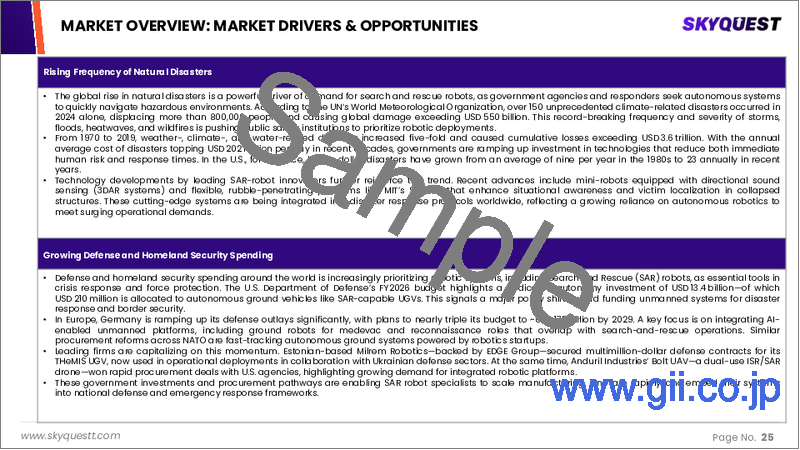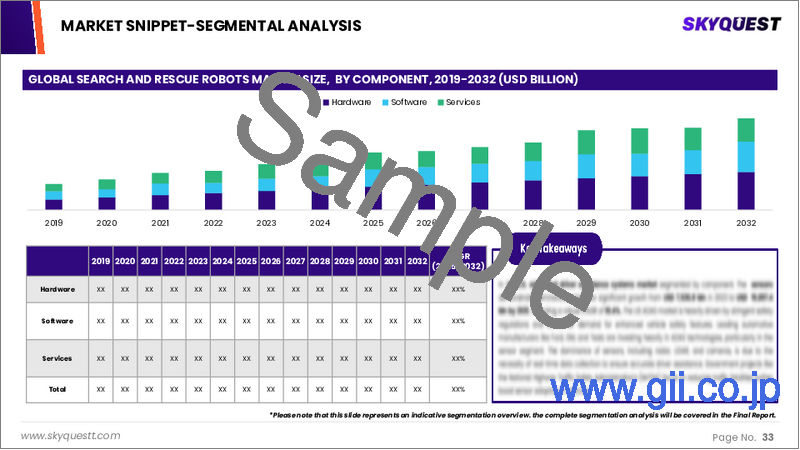|
|
市場調査レポート
商品コード
1629029
捜索救助ロボットの市場規模、シェア、成長分析、タイプ別、用途別、技術別、エンドユーザー別、地域別 - 産業予測、2025~2032年Search and Rescue Robots Market Size, Share, Growth Analysis, By Type (Ground Robots, Aerial Robots), By Application (Disaster Response, Firefighting), By Technology, By End-User, By Region - Industry Forecast 2025-2032 |
||||||
|
|||||||
| 捜索救助ロボットの市場規模、シェア、成長分析、タイプ別、用途別、技術別、エンドユーザー別、地域別 - 産業予測、2025~2032年 |
|
出版日: 2025年01月06日
発行: SkyQuest
ページ情報: 英文 261 Pages
納期: 3~5営業日
|
全表示
- 概要
- 目次
捜索救助ロボットの世界市場規模は、2023年に265億米ドルと評価され、予測期間(2025-2032年)にCAGR 20.6%で成長し、2024年の319億6,000万米ドルから2032年には1,430億1,000万米ドルに成長する見通しです。
捜索救助ロボット市場は、ロボット工学、AI、センサー、通信技術の進歩に後押しされ、大きな成長を遂げています。自然災害や緊急事態の増加により、こうした特殊なロボットの需要が世界中で高まっています。また、安全規制への準拠も、さまざまな分野での製造と配備を後押ししています。メーカー間の熾烈な競争は、技術革新と差別化された製品提供を促進するが、初期費用が高いことは、予算が限られている小規模な事業体にとっては障壁となります。政府機関、民間企業、研究機関の戦略的パートナーシップは、市場の革新と拡大をさらに促進します。さらに、捜索救助ロボットの利点と能力に関する認識を高める教育的イニシアチブは、市場開発にとって極めて重要であり、利害関係者が危機的状況においてその価値を認識することを保証します。
目次
イントロダクション
- 調査の目的
- 調査範囲
- 定義
調査手法
- 情報調達
- 二次データと一次データの方法
- 市場規模予測
- 市場の前提条件と制限
エグゼクティブサマリー
- 世界市場の見通し
- 供給と需要の動向分析
- セグメント別機会分析
市場力学と見通し
- 市場概要
- 市場規模
- 市場力学
- 促進要因と機会
- 抑制要因と課題
- ポーターの分析
主な市場の考察
- 重要成功要因
- 競合の程度
- 主な投資機会
- 市場エコシステム
- 市場の魅力指数(2024年)
- PESTEL分析
- マクロ経済指標
- バリューチェーン分析
- 価格分析
- 技術分析
- 規制分析
- 特許分析
- ケーススタディ
捜索救助ロボット市場規模:タイプ別
- 市場概要
- 地上ロボット
- 航空ロボット
- ハイブリッドロボット
捜索救助ロボット市場規模:用途別
- 市場概要
- 災害対応
- 消防
- 軍事と防衛
- 産業救助
- 法執行機関
- 土木工学
- その他
捜索救助ロボット市場規模:技術別
- 市場概要
- 自律型ロボット
- 遠隔操作ロボット
- 半自律型ロボット
捜索救助ロボット市場規模:エンドユーザー別
- 市場概要
- 政府機関
- 防衛と軍事
- 消防署
- 緊急サービス
- 産業用途
- 調査機関
- その他
捜索救助ロボット市場規模
- 北米
- 米国
- カナダ
- 欧州
- ドイツ
- スペイン
- フランス
- 英国
- イタリア
- その他欧州地域
- アジア太平洋地域
- 中国
- インド
- 日本
- 韓国
- その他アジア太平洋地域
- ラテンアメリカ
- ブラジル
- その他ラテンアメリカ地域
- 中東・アフリカ
- GCC諸国
- 南アフリカ
- その他中東・アフリカ
競合情報
- 上位5社の比較
- 主要企業の市場ポジショニング(2024年)
- 主な市場企業が採用した戦略
- 市場の最近の動向
- 企業の市場シェア分析(2024年)
- 主要企業の企業プロファイル
- 会社概要
- 製品ポートフォリオ分析
- セグメント別シェア分析
- 収益の前年比比較(2022-2024)
主要企業プロファイル
- Boston Dynamics(US)
- Hydronalix(US)
- Kongsberg Maritime(Norway)
- Lockheed Martin Corporation(US)
- FLIR Systems Inc.(US)
- Howe & Howe Technologies Inc.(US)
- Northrop Grumman Corporation(US)
- Saab AB(Sweden)
- Thales Group(France)
- Elbit Systems Ltd.(Israel)
- Textron Systems Corporation(US)
- DEEPRobotics Technology Co., Ltd.(China)
- Pliant Energy Systems(US)
- Leotronics LLC(US)
- VideoRay LLC(US)
- Shark Robotics(France)
- Ripper Corp.(US)
- Hydronalix(US)
結論と推奨事項
Global Search and Rescue Robots Market size was valued at USD 26.5 billion in 2023 and is poised to grow from USD 31.96 billion in 2024 to USD 143.01 billion by 2032, growing at a CAGR of 20.6% during the forecast period (2025-2032).
The search and rescue robot market is experiencing significant growth, propelled by advancements in robotics, AI, sensors, and communication technologies. Increasing incidences of natural disasters and emergencies are heightening the demand for these specialized robots worldwide. Compliance with safety regulations also dictates their manufacturing and deployment across various sectors. Intense rivalry among manufacturers fosters innovation and distinct product offerings, although high initial costs represent a barrier for smaller entities with tighter budgets. Strategic partnerships among government bodies, private firms, and research institutions further drive market innovation and expansion. Additionally, educational initiatives that raise awareness about the benefits and capabilities of search and rescue robots are crucial for market development, ensuring that stakeholders recognize their value in crisis situations.
Top-down and bottom-up approaches were used to estimate and validate the size of the Global Search And Rescue Robots market and to estimate the size of various other dependent submarkets. The research methodology used to estimate the market size includes the following details: The key players in the market were identified through secondary research, and their market shares in the respective regions were determined through primary and secondary research. This entire procedure includes the study of the annual and financial reports of the top market players and extensive interviews for key insights from industry leaders such as CEOs, VPs, directors, and marketing executives. All percentage shares split, and breakdowns were determined using secondary sources and verified through Primary sources. All possible parameters that affect the markets covered in this research study have been accounted for, viewed in extensive detail, verified through primary research, and analyzed to get the final quantitative and qualitative data.
Global Search And Rescue Robots Market Segmental Analysis
Global Search and Rescue Robots Market is segmented by Type, Application, Technology, End-User and region. Based on Type, the market is segmented into Ground Robots, Aerial Robots and Hybrid Robots. Based on Application, the market is segmented into Disaster Response, Firefighting, Military and Defense, Industrial Rescue, Law Enforcement, Civil Engineering and Others. Based on Technology, the market is segmented into Autonomous Robots, Teleoperated Robots and Semi-autonomous Robots. Based on End-User, the market is segmented into Government Agencies, Defense and Military, Fire Departments, Emergency Services, Industrial Applications, Research Institutes and Others. Based on region, the market is segmented into North America, Europe, Asia Pacific, Latin America and Middle East & Africa.
Driver of the Global Search And Rescue Robots Market
The global Search and Rescue Robots market is significantly driven by advancements in robotic technology that enhance their utility in perilous situations. These robots are designed to operate tirelessly for extended periods, allowing them to access challenging terrains that may pose risks to human rescuers. Their ability to navigate hazardous environments makes them indispensable for gathering crucial information prior to initiating recovery operations. By surveying affected areas, rescue robots enable teams to pinpoint locations of victims, thus optimizing resource allocation and enhancing the effectiveness of rescue missions. The reliance on these advanced technological tools is increasingly shaping the landscape of emergency response.
Restraints in the Global Search And Rescue Robots Market
One of the key challenges facing the Global Search and Rescue Robots market is the growing safety concerns associated with the deployment of humanoid robots in environments where they interact closely with humans. The inherent risks posed by these robots necessitate stringent safety measures to minimize the likelihood of accidents or malfunctions that could lead to injuries or property damage. Such incidents not only pose serious legal implications but can also substantially undermine public confidence in the technology. As a result, the hesitation surrounding the safe usage of humanoid robots may lead to a slowdown in market growth and adoption.
Market Trends of the Global Search And Rescue Robots Market
The global search and rescue robots market is witnessing a significant upward trend, driven by escalating government investments aimed at enhancing disaster management capabilities. As nations face a growing frequency of natural calamities, the deployment of sophisticated search and rescue robots has proven invaluable in efficiently locating victims and assessing hazardous conditions. Their ability to gather critical data, streamline operations, and assist first responders has led to widespread adoption among fire brigades, law enforcement, and military organizations. This proactive approach from governments not only elevates operational efficiency but also reinforces the need for advanced robotics in ensuring public safety, solidifying the market's growth trajectory.
Table of Contents
Introduction
- Objectives of the Study
- Scope of the Report
- Definitions
Research Methodology
- Information Procurement
- Secondary & Primary Data Methods
- Market Size Estimation
- Market Assumptions & Limitations
Executive Summary
- Global Market Outlook
- Supply & Demand Trend Analysis
- Segmental Opportunity Analysis
Market Dynamics & Outlook
- Market Overview
- Market Size
- Market Dynamics
- Drivers & Opportunities
- Restraints & Challenges
- Porters Analysis
- Competitive rivalry
- Threat of substitute
- Bargaining power of buyers
- Threat of new entrants
- Bargaining power of suppliers
Key Market Insights
- Key Success Factors
- Degree of Competition
- Top Investment Pockets
- Market Ecosystem
- Market Attractiveness Index, 2024
- PESTEL Analysis
- Macro-Economic Indicators
- Value Chain Analysis
- Pricing Analysis
- Technology Analysis
- Regulatory Analysis
- Patent Analysis
- Case Studies
Global Search and Rescue Robots Market Size by Type & CAGR (2025-2032)
- Market Overview
- Ground Robots
- Aerial Robots
- Hybrid Robots
Global Search and Rescue Robots Market Size by Application & CAGR (2025-2032)
- Market Overview
- Disaster Response
- Firefighting
- Military and Defense
- Industrial Rescue
- Law Enforcement
- Civil Engineering
- Others
Global Search and Rescue Robots Market Size by Technology & CAGR (2025-2032)
- Market Overview
- Autonomous Robots
- Teleoperated Robots
- Semi-autonomous Robots
Global Search and Rescue Robots Market Size by End-User & CAGR (2025-2032)
- Market Overview
- Government Agencies
- Defense and Military
- Fire Departments
- Emergency Services
- Industrial Applications
- Research Institutes
- Others
Global Search and Rescue Robots Market Size & CAGR (2025-2032)
- North America (Type, Application, Technology, End-User)
- US
- Canada
- Europe (Type, Application, Technology, End-User)
- Germany
- Spain
- France
- UK
- Italy
- Rest of Europe
- Asia Pacific (Type, Application, Technology, End-User)
- China
- India
- Japan
- South Korea
- Rest of Asia-Pacific
- Latin America (Type, Application, Technology, End-User)
- Brazil
- Rest of Latin America
- Middle East & Africa (Type, Application, Technology, End-User)
- GCC Countries
- South Africa
- Rest of Middle East & Africa
Competitive Intelligence
- Top 5 Player Comparison
- Market Positioning of Key Players, 2024
- Strategies Adopted by Key Market Players
- Recent Developments in the Market
- Company Market Share Analysis, 2024
- Company Profiles of All Key Players
- Company Details
- Product Portfolio Analysis
- Company's Segmental Share Analysis
- Revenue Y-O-Y Comparison (2022-2024)
Key Company Profiles
- Boston Dynamics (US)
- Company Overview
- Business Segment Overview
- Financial Updates
- Key Developments
- Hydronalix (US)
- Company Overview
- Business Segment Overview
- Financial Updates
- Key Developments
- Kongsberg Maritime (Norway)
- Company Overview
- Business Segment Overview
- Financial Updates
- Key Developments
- Lockheed Martin Corporation (US)
- Company Overview
- Business Segment Overview
- Financial Updates
- Key Developments
- FLIR Systems Inc. (US)
- Company Overview
- Business Segment Overview
- Financial Updates
- Key Developments
- Howe & Howe Technologies Inc. (US)
- Company Overview
- Business Segment Overview
- Financial Updates
- Key Developments
- Northrop Grumman Corporation (US)
- Company Overview
- Business Segment Overview
- Financial Updates
- Key Developments
- Saab AB (Sweden)
- Company Overview
- Business Segment Overview
- Financial Updates
- Key Developments
- Thales Group (France)
- Company Overview
- Business Segment Overview
- Financial Updates
- Key Developments
- Elbit Systems Ltd. (Israel)
- Company Overview
- Business Segment Overview
- Financial Updates
- Key Developments
- Textron Systems Corporation (US)
- Company Overview
- Business Segment Overview
- Financial Updates
- Key Developments
- DEEPRobotics Technology Co., Ltd. (China)
- Company Overview
- Business Segment Overview
- Financial Updates
- Key Developments
- Pliant Energy Systems (US)
- Company Overview
- Business Segment Overview
- Financial Updates
- Key Developments
- Leotronics LLC (US)
- Company Overview
- Business Segment Overview
- Financial Updates
- Key Developments
- VideoRay LLC (US)
- Company Overview
- Business Segment Overview
- Financial Updates
- Key Developments
- Shark Robotics (France)
- Company Overview
- Business Segment Overview
- Financial Updates
- Key Developments
- Ripper Corp. (US)
- Company Overview
- Business Segment Overview
- Financial Updates
- Key Developments
- Hydronalix (US)
- Company Overview
- Business Segment Overview
- Financial Updates
- Key Developments






